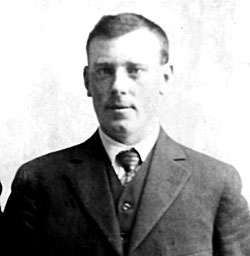
John D. O'Conner Photo from 1920's
By LEE JUILLERAT
Freelance Writer
KLAMATH FALLS, Ore. Most people think of southeastern Oregon as cattle country. Drive around Klamath Falls, over to Merrill, around Fort Klamath, over the Lakeview and Burns, or south of the Oregon-California state line between Canby and Alturas and thousands of cattle are lazily grazing.
Jack O'Connor remembers an era when sheep dominated the range. In the early 1900s it's estimated Lake County had upwards of 350,000 sheep, while Klamath County tallied another 160,000 and Modoc County in far northeastern California had upwards of 60,000. O'Connors family was part of the sheep industry, at one time claiming more than 15,000 breeding ewes.
"Sheep were a good business for a long time," says O'Connor, 79. "In the early days you couldn't drive across the county seeing bands of sheep, some in pastures, some being trailed to town from the ranges. Spring and fall were the busiest times for trailing, an early fall shipping fat lambs by rail later, trucks."
Restaurants in San Francisco, along with Los Angeles and Chicago, were the main buyers "There were thousands of sheep and they got eaten up." The O'Connors were major players in the sheep industry. At one time the O'Connor Livestock Company had vast holdings in Oregon and California. "From May to June you could see lambs playing the fields along the highway when the sun was out. Sheep were a big industry in those days.
Several thousand people depended on sheep for their livelihood, from employment to selling the needs of the sheep industry," laments O'Connor. "Not many of us are alive today to remember." The O'Connor story began when Jack's father, John D., left Ireland for the Lake County in 1911 as a 16-year-old. Like others, John D. traveled to Lake County to work for an established Irish sheepman. "I think the relatives just kept bringing their relatives," says 'Connor. "The Irish pretty well controlled Lake County."
John D. was drafted into the U.S. Army and sent overseas in 1916 to fight in France during World War I. He returned in 1918. With his brother, Jerry, who moved west from New York, they bought the 160-acre Tom Martin Ranch south of Klamath Falls. John D. and Jerry were joined by a third brother, Matt, from Ireland. Jerry was the buyer, John D. the farmer and Matt the sheepman. Jerry died in 1941. Matt retired in 1944 and returned to Ireland. The brothers had a small dairy and grew grain and spuds but, as Jack explains, "The grain froze, the dairy didn't produce enough and the spuds were not steady, so the sheep won out. Sheep seemed to be what they could do best."
The O'Connors added land and sheep, a cross of Rambiollet and Columbia. During peak periods they employed 35 people.
Each winter sheep were loaded onto trains and transported to Maxwell, Calif. Each spring sheep grazed in the Lava Beds National Monument and in summer moved to ranges near Chiloquin and Lenz.
John D. married Violette Matney, who lived on a nearby ranch, in 1920. Jack, who was born in 1925, was the youngest of four children. Jack married Theresa Taucher of Maxwell, Calif. They had five children. Theresa died in 1982 and O'Connor remarried a year later. He and his wife, Muriel, live in Klamath Falls.
He says the sheep's industry demise stemmed from various factors, including passage of the 1934 Taylor Grazing Act increasingly stringent predator controls. The loss of sheep, he believes, is significant.
"The sheep industry has been given a wrong image. It (grazing) groomed the forests so the wildlife could use it and kept the fuels for (forest) fires in check. Kept the brush from getting too big for deer use. Grazing converted a fire hazard into food and fiber," he insists. "Sheep were great weed controllers along ditches, roads and unfarmed areas." Instead of having to burn stubble and leftover hay, he says sheep grazed and cleaned those fields, and provided natural organic fertilizer.
"Animals weren't put on this land to be locked up and looked at. They have a job to do," believes O'Connor, who calls sheep "groomers of the forest. They were stabilizers. You went on the land and make food and fiber out of water." The O'Connor Livestock Company "dwindled down " its sheep operation and increased its cattle numbers. By 1972 they had 2,600 sheep. In 1975, with prices for wool and lamb declining severely, they sold their remaining sheep. The ranch is managed by O'Connor's son, Tim, who about runs 800 head of Hereford cattle near Lower Klamath Lake. O'Connor has no flock, but he remains a sheepman. "I think they're a sacred animal," believes O'Connor. "One time a cattleman friend of mine was giving me a hard time about sheep. I told him I've never seen a picture of God holding a calf."